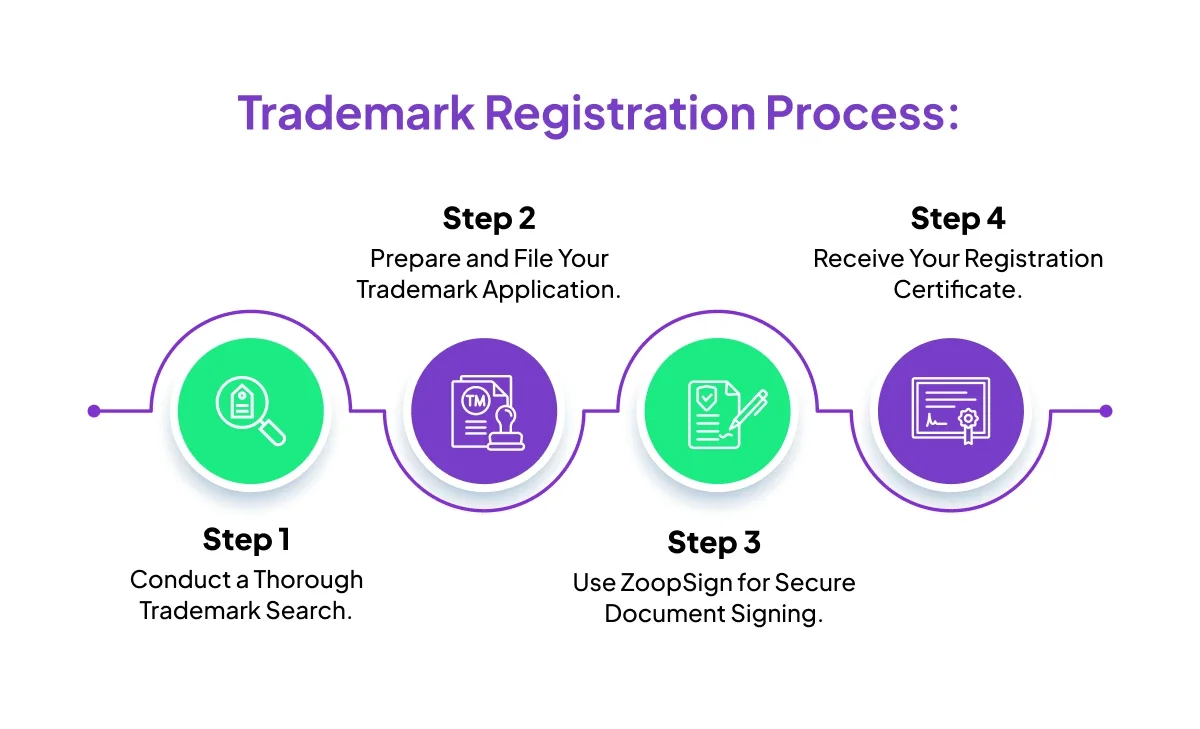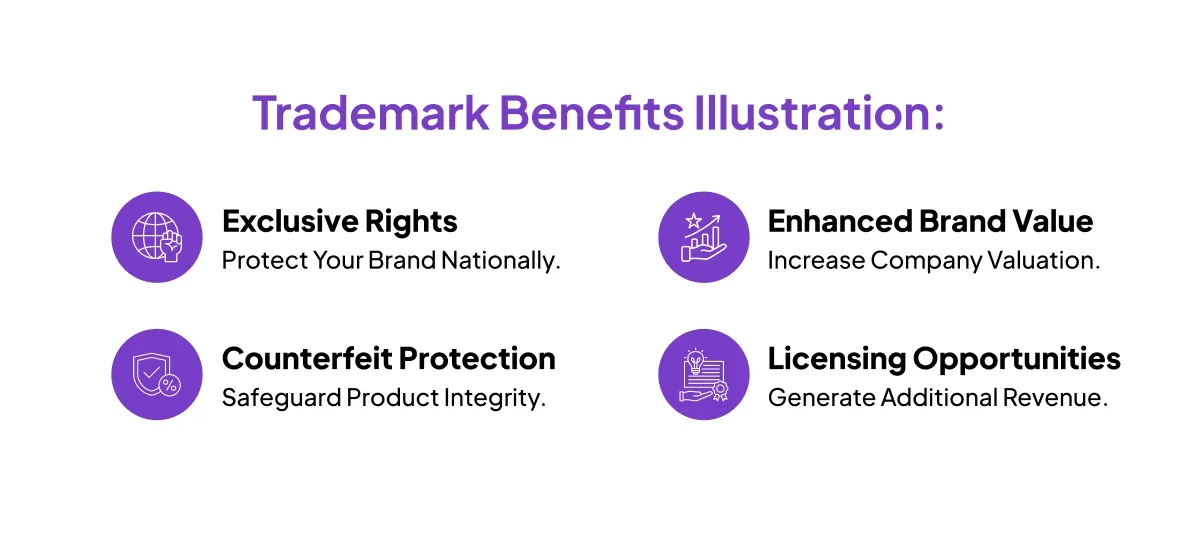If you’re a startup founder, small business owner, or established enterprise, securing your brand identity through trademark registration provides crucial legal protection and business advantages.
India has emerged as a significant player in the global trademark landscape, recording an impressive 537,000 trademark applications in 2024 with a 10% average yearly growth over the past decade.
Keep reading to know more in detail about trademark registration - from its fundamental meaning to the step-by-step process, key benefits, and eligibility requirements.
What is Trademark Registration and Why Does It Matter?
Trademark registration is the formal process of legally protecting a unique identifier that distinguishes your goods or services from others in the marketplace. This identifier could be a name, logo, symbol, phrase, sound, or even a specific color combination that represents your brand.
When you register a brand, you gain exclusive legal rights to use that mark in connection with the specific goods or services listed in your application. This exclusivity extends throughout the entire country where you’ve registered the trademark.
The Trade Marks Act, 1999, governs the legal framework for trademark registration in India, and the Trade Marks Rules, 2017, which align with international standards and provide robust protection for brand owners.
Trademark registration provides legal protection for your brand identity in the competitive market. Without this protection, competitors could potentially use similar marks, causing confusion among consumers and potentially damaging your business reputation and revenue.
Understanding the Trademark Registration Process in India
The trademark registration process typically takes between 12-18 months to complete in India. Understanding each step in the trademark registration process can help avoid common pitfalls and ensure a smoother experience.
How to Register a Trademark in India: Step-by-Step Guide
Learning how to register a trademark in India is crucial for both startups and established businesses. Here’s a detailed breakdown of the procedure:
1. Conduct a Trademark Search
Before filing your application, conducting a thorough trademark search is essential to avoid rejection. A comprehensive trademark search helps identify potential conflicts with existing marks that could lead to objections. The official trademark search database can be accessed through the IPIndia website.
2. Prepare and File Your Application
Your trademark application must include clear representations of the mark you wish to protect, along with details about the goods or services it will represent. The application requires:
- Applicant details (name, address, nationality)
- Representation of the mark
- List of goods/services
- User declaration (whether the mark is already in use or proposed to be used)
- Power of attorney (if filed through an agent)
3. The trademark filing date
It establishes your priority over subsequent similar applications. Digital solutions have made trademark filing more accessible to small businesses. You can choose between online and offline filing methods, though trademark registration online offers greater convenience.
4. Pay the Required Fees
Trademark registration fees vary based on factors such as the number of classes, the type of applicant, and the filing method. For individuals and startups, the fees are typically lower than for large companies. The current fee structure includes:
- For individuals/startups/small enterprises: ₹4,500 per class (online filing)
- For companies: ₹9,000 per class (online filing)
- Physical filing incurs additional cost
5. Examination Process
After filing, your application undergoes examination by the Trademark Registry. An examiner reviews your application to ensure it meets all legal requirements and doesn’t conflict with existing marks. This examination typically occurs within 3-4 months after filing.
If the examiner raises objections, you’ll receive an examination report outlining the issues. You’ll have one month to respond with arguments or amendments to address these concerns.
6. Publication in the Trademark Journal
If your application passes the examination, it’s published in the Trademark Journal. This publication allows third parties to oppose your application if they believe it conflicts with their rights. The opposition period lasts for four months from the date of publication.
7. Registration Certificate
If no opposition is filed (or if you successfully overcome any opposition), your trademark will proceed to registration. You’ll receive a registration certificate, and your mark will be protected for 10 years from the application date.
8. Trademark Renewal
Trademark renewal must be completed every 10 years to maintain your protection. Setting reminders for trademark renewal deadlines is essential for continuous brand protection. The trademark renewal process can be initiated 6 months before the expiration date.
Documents Required for Trademark Registration
Preparing the right documentation is crucial for a successful trademark application. Here’s what you’ll need:
- Representation of the Mark: Clear image of your logo/wordmark (JPEG/GIF format for online filing)
- Proof of Identity: Aadhaar card, PAN card, passport, or voter ID
- Proof of Address: Utility bills, bank statements, or government-issued documents
- Business Proof: Certificate of incorporation, partnership deed, or shop establishment certificate
- Power of Attorney: If filing through an agent
- User Declaration: Affidavit stating whether the mark is already in use or proposed to be used
- Priority Documents: If claiming priority based on an earlier filing in another country
Read: What is an Affidavit? Meaning and Purpose
Benefits of Trademark Registration
Registering your trademark offers numerous advantages that extend beyond basic legal protection. Here are the key benefits:
1. Exclusive Nationwide Rights
Trademark registration grants you exclusive rights to use your mark throughout India. Many businesses underestimate the importance of trademark registration until they face infringement issues. With registered protection, you can legally prevent others from using identical or deceptively similar marks for related goods or services.
2. Legal Ownership Proof
A registered trademark serves as prima facie evidence of your ownership. This makes it significantly easier to defend your rights in legal disputes, as the burden of proof shifts to the challenging party.
3. Brand Value Enhancement
trademark business name (additional keyword): Protecting your trademark business name prevents competitors from using similar identifiers. Your trademark business name is a valuable asset that can appreciate over time. Registered trademarks are intangible assets that can substantially increase your company’s valuation, making them particularly valuable during fundraising, mergers, or acquisitions.
4. Licensing Opportunities
Registration allows you to license your trademark to others, creating additional revenue streams. You can control how others use your mark while benefiting financially from licensing agreements.
5. Protection Against Counterfeiting
With a registered trademark, you gain stronger legal grounds to take action against counterfeiters and infringers. This helps maintain your product quality reputation and protects consumers from inferior imitations.
6. Business Expansion Support
As your business grows, a registered trademark facilitates expansion into new markets. It also provides a foundation for international trademark protection through mechanisms like the Madrid Protocol.
Eligibility Criteria for Trademark Registration
Not all marks qualify for trademark registration. Understanding the eligibility criteria can save you time and resources:
Who Can Apply for a Trademark?
- Individual proprietors
- Partnership firms
- Companies and corporations
- Trusts and societies
- Association of persons
- Any legal entity capable of owning and transferring property
What Can Be Trademarked?
A trademark can include:
- Words and names
- Signatures
- Logos and symbols
- Letters and numerals
- Shape of goods or packaging
- Color combinations
- Sound marks
- 3D shapes
What Cannot Be Trademarked?
Certain marks are ineligible for registration:
- Generic terms or common trade descriptions
- Marks lacking distinctive character
- Marks that may deceive the public
- Marks containing scandalous or obscene matter
- Marks prohibited under the Emblems and Names Act
- Marks identical or similar to existing registered trademarks
- Marks that may hurt religious sentiments
Trademark Registration Online: The Digital Advantage
Trademark registration online offers convenience and typically faster processing times. The government portal for trademark registration online provides user-friendly navigation, making the process more accessible to applicants without specialized legal knowledge.
The digital transformation of the trademark registration system in India has significantly improved efficiency. Online filing reduces paperwork, enables faster communication with the registry, and provides real-time status updates on your application.
How ZoopSign Simplifies the Trademark Process
While ZoopSign doesn’t directly handle trademark registration, its digital signature solutions complement several aspects of the trademark registration process. When preparing your trademark application and related documents, ZoopSign’s electronic signature services can help:
- Secure Document Signing: ZoopSign’s Aadhaar eSign and Digital eSign solutions ensure that all your trademark documentation is securely signed and legally valid under the IT Act.
- Efficiency Improvement: With up to 80% reduction in signing time, ZoopSign streamlines the document preparation phase of your trademark application.
- Multi-Format Support: Whether your trademark documents are in PDF or Word format, ZoopSign supports seamless signing acxfross different file types.
- Authentication Security: Multiple authentication methods ensure that all signatures on your trademark documents are legitimate and verifiable.
For businesses managing multiple trademark applications or handling trademark renewals, ZoopSign’s digital signature platform can significantly reduce administrative burden and ensure compliance with legal requirements.
Check: Business Growth with Zoopsign
Conclusion
Whether you’re launching a new brand or seeking to protect an established one, understanding the trademark registration process, benefits, and eligibility criteria is essential for making informed decisions about your intellectual property strategy.
Remember that while the application process can be navigated independently, complex cases may benefit from professional legal assistance.
And for all your document signing needs throughout the trademark journey, ZoopSign’s digital signature solutions can help streamline the process while ensuring legal compliance.
Ready to protect your brand identity? Start your trademark registration journey today and secure your business’s most valuable assets for the future.


